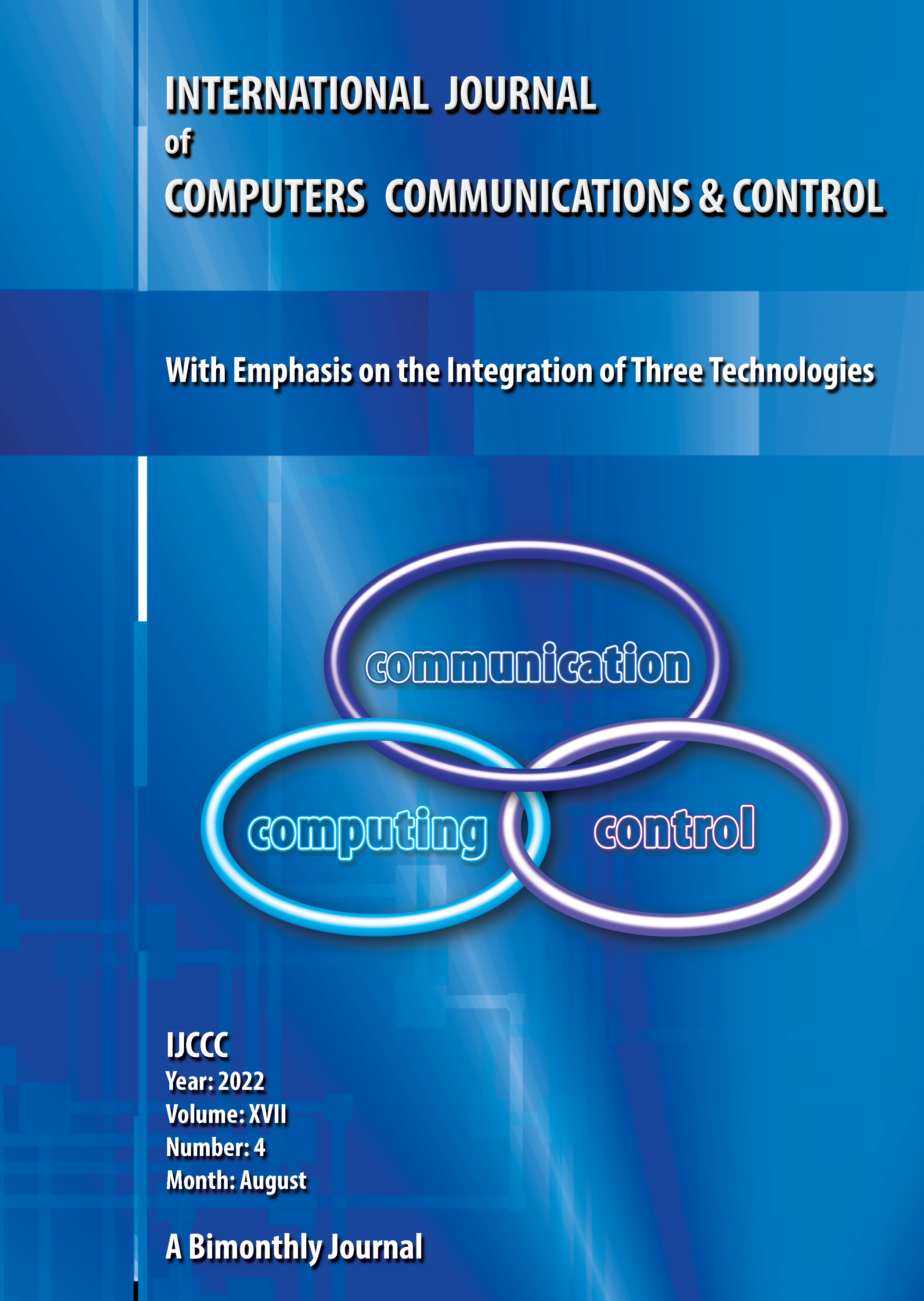Optimization of Road Traffic Using Intelligent Traffic Light Systems
DOI:
https://doi.org/10.15837/ijccc.2022.4.4866Keywords:
Traffic lights, Traffic congestion, OptimizationAbstract
If we consider road traffic in urban areas, one of its major problems encountered nowadays is that of traffic congestion. The paper aims to provide an improvement, in terms of reducing traffic congestion, by analyzing different traffic light cycles. A traffic light cycle is determined by the red and green duration of the traffic lights. Traditionally these two have a fixed duration and controlling road traffic can be achieved by modifying it, resulting in a congestion reduction. We present a comparison between the fixed and an improved fixed situation, as well as a QL algorithm to further reduce the congestion at an intersection. Urban traffic can thus be optimized, in terms of reducing congestion, on an existing traffic light system. A study case validates the results, based on road traffic data obtained from the city of Bucharest.
References
W.F. Adams (1936). Road Traffic Considered as a Random Series, J. Inst. Civil Engineers, vol. 4, pp. 121-130, 1936.
https://doi.org/10.1680/ijoti.1936.14802
L.A. Pipes, (1953). An Operational Analysis of Traffic Dynamics, Journal of Applied Physics, Vol. 24(3), pp. 274-281, 1953.
https://doi.org/10.1063/1.1721265
R.E. Chandler, R. Herman, E.W. Montroll (1958). Traffic dynamics: studies in car following, Operation Research 6, pp.165-184, 1958.
https://doi.org/10.1287/opre.6.2.165
M.H. Lighthill, G.B. Whitham (1955). On kinematic waves II: a theory of traffic flow on long crowded roads, Proceedings of the Royal Society, London Series A, 229, pp. 317-345, 1955.
https://doi.org/10.1098/rspa.1955.0089
P.I. Richards (1955). Shockwaves on the highway, Operations Research 4(1), pp. 42-51. 1956.
https://doi.org/10.1287/opre.4.1.42
J.G. Wardrop (1952) Some Theoretical Aspects of Road Traffic Research, Proceedings of the Institution of Civil Engineers, Part II, 1(2), pp. 325-362, 1952.
https://doi.org/10.1680/ipeds.1952.11259
H.J. Payne (1971). Models of freeway traffic and control, Math. Models Publ. Sys, 28, pp. 51-61, 1971.
G.B. Whitham (1974). Linear and nonlinear waves, New York: Wiley, 1974.
S.P. Hoogendoorn, P.H.L. Bovy (2001). State-of-the-art of Vehicular Traffic Flow Modelling, Proceedings of the I MECH E Part I Journal of Systems & Control Engineering, Volume 215, Number 4, 19 August 2001, pp. 283-303, 2001.
https://doi.org/10.1177/095965180121500402
L. Jacome et all, A Survey on Intelligent Traffic Lights (2018). IEEE International Conference on Automation/XXIII Congress of the Chilean Association of Automatic Control (ICA-ACCA), Conception, Chile, 2018.
https://doi.org/10.1109/ICA-ACCA.2018.8609705
A.R. Rosyadi, T.A.B. Wirayuda, S. Al-Faraby (2016) Intelligent traffic light control using collaborative Q-Learning algorithms, 4th International Conference on Information and Communication Technology (ICoICT), Bandung, Indonesia, 2016.
https://doi.org/10.1109/ICoICT.2016.7571925
Y. Liu, W.P. Chen (2017). Intelligent traffic light control using distributed multi-agent Q learning, IEEE 20th International Conference on Intelligent Transportation Systems (ITSC), Yokohama, Japan, 2017.
https://doi.org/10.1109/ITSC.2017.8317730
[Online]. Available: https://www.tomtom.com/en_gb/traffic-index/bucharest-traffic/ Bucharest traffic report - TomTom Traffic Index, Accesed on 17 June 2022.
Additional Files
Published
Issue
Section
License
Copyright (c) 2022 Catalin Dimon, Dumitru Popescu, Marius Teme

This work is licensed under a Creative Commons Attribution-NonCommercial 4.0 International License.
ONLINE OPEN ACCES: Acces to full text of each article and each issue are allowed for free in respect of Attribution-NonCommercial 4.0 International (CC BY-NC 4.0.
You are free to:
-Share: copy and redistribute the material in any medium or format;
-Adapt: remix, transform, and build upon the material.
The licensor cannot revoke these freedoms as long as you follow the license terms.
DISCLAIMER: The author(s) of each article appearing in International Journal of Computers Communications & Control is/are solely responsible for the content thereof; the publication of an article shall not constitute or be deemed to constitute any representation by the Editors or Agora University Press that the data presented therein are original, correct or sufficient to support the conclusions reached or that the experiment design or methodology is adequate.








